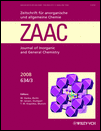Supramolecular Stuctures from Mononuclear, Binuclear and 2D Net of Copper(II) Complexes with 6-Hydroxypicolinic Acid
Abstract
First examples of transition metal complexes with HpicOH [Cu(picOH)2(H2O)2] (1), [Cu(picO)(2,2′-bpy)]·2H2O (2), [Cu(picO)(4,4′-bpy)0.5(H2O)]n (3), and [Cu(picO)(bpe)0.5(H2O)]n (4) (HpicOH = 6-hydroxy-picolinic acid; 2,2′-bpy = 2,2′-bipyridine; 4,4′-bpy = 4,4′-bipyridine; bpe = 1,2-bis(4-pyridyl)ethane) have been synthesized and characterized by single-crystal X-ray diffraction. The results show that HpicOH ligand can be in the enol or ketonic form, and adopts different coordination modes under different pH value of the reaction mixture. In complex 1, HpicOH ligand is in the enol form and adopts a bidentate mode. While in complexes 2–4, as the pH rises, HpicOH ligand becomes in the ketonic form and adopts a tridentate mode. The coordination modes in complexes 1–4 have not been reported before. Because of the introduction of the terminal ligands 2,2′-bpy, complex 2 is of binuclear species; whereas in complexes 3 and 4, picO ligands together with bridging ligands 4,4′-bpy and bpe connect CuII ions to form 2D nets with (123)2(12)3 topology.




